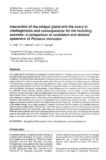Perlihatkan publikasi sederhana
Interaction between test and reference populations when tilapia strains are compared by the “internal control” technique
| dc.contributor.author | Basiao, Zubaida U. | |
| dc.contributor.author | Doyle, Roger W. | |
| dc.date.accessioned | 2012-11-07T05:57:39Z | |
| dc.date.available | 2012-11-07T05:57:39Z | |
| dc.date.issued | 1990 | |
| dc.identifier.citation | Basiao, Z.U., & Doyle, R.W. (1990). Interaction between test and reference populations when tilapia strains are compared by the "internal control" technique. Aquaculture, 85(1–4), 207–214. | en |
| dc.identifier.issn | 0044-8486 | |
| dc.identifier.uri | http://hdl.handle.net/10862/1210 | |
| dc.description.abstract | Several strains of Oreochromis niloticus, O. mossambicus and their hybrids occur in the Philippines, and others are likely to be introduced or developed locally in the near future. Our objective was to study biological interaction. The paper reports on an experimental design in which "reference" fish are included in each replicate to provide internal statistical control. Growth of 10 full-sib families from each of two domestic strains was compared. A third strain of red tilapia was mass spawned to provide reference fish. Thirty equal-sized fry from each family were matched with 30 red tilapia fry and reared for 8 weeks in laboratory aquaria. The fish were deliberately crowded to provide a "worst-case scenario" for the application of the reference-strain technique. The objective was to see whether behavioural interaction causes statistical or genotype × environment interactions that create problems in the analysis. The test strains interacted biologically with the reference strain in different ways: the growth (change in length) of strain 1 only was negatively correlated with reference growth. Statistical interaction did occur in this extreme situation. We speculate that the reference-fish technique will be more useful in experiments in ponds or cages, where variable environmental factors induce positive, rather than negative, correlations between reference and test strains. | en |
| dc.language.iso | en | en |
| dc.publisher | Elsevier | en |
| dc.subject | Oreochromis niloticus | en |
| dc.subject | Oreochromis mossambicus | en |
| dc.subject | genotype environment interaction | en |
| dc.title | Interaction between test and reference populations when tilapia strains are compared by the “internal control” technique | en |
| dc.type | Article | en |
| dc.identifier.doi | 10.1016/0044-8486(90)90020-N | |
| dc.citation.volume | 85 | |
| dc.citation.issue | 1-4 | |
| dc.citation.spage | 207 | |
| dc.citation.epage | 214 | |
| dc.citation.journalTitle | Aquaculture | en |
| dc.subject.asfa | cultured organisms | en |
| dc.subject.asfa | genetics | en |
| dc.subject.asfa | hybrids | en |
| dc.subject.asfa | fish culture | en |
| dc.subject.asfa | behaviour | en |
| dc.subject.asfa | aquaculture | en |
| dc.subject.asfa | interactions | en |
Files in this item
| Files | Size | Format | View |
|---|---|---|---|
|
There are no files associated with this item. |
|||
Publikasi ini ada di koleksi berikut
-
Journal Articles [1256]
These papers were contributed by Department staff to various national and international journals.




